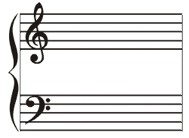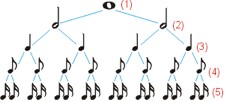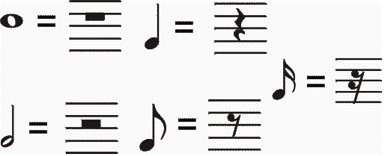|
The Staff, Note Names, Rhythms, Tablature
E, F, and G, Open String Arpeggios
Reading Music
The Staff
The staff is the
basis of written music. It is what the notes are presented on. It
consists of 5 lines with four spaces between them. A simple, unadorned
staff is shown below.

Clefs

This is the
treble staff. The treble clef (the large fancy symbol to the far left)
shows the musician that the staff is treble. Since it curls around the
G line, it is also called a G clef. The treble staff begins with the
first line as E. Each successive space and line is the next letter in
the musical alphabet. The staff ends with the last line as an F. Many
mnemonic devices exist to help a person remember which line and space
is which. One of the most common phrases to remember the names of the
lines is: Every Good Boy Does
Fine. (Also
popular is Elvis' Guitar Broke Down Friday). To remember the spaces,
just remember that they spell FACE
starting from the bottom.

This is the bass
(pronounced 'base' ) staff. The bass clef, also known as the F clef
because it locates the line known as F, is on the far left. The bass
clef uses the same musical alphabet as treble, but the letters start in
different places. Instead of an E, the bottom line is a G, and the
letters proceed logically from there. Again, simple mnemonics can be
used to remember the names of the notes. The lines on the bass cleft,
from bottom to top are: G, B, D, F, A (Good
Boys Don't Fight Anyone), and the spaces are A,C,E,G (All Cows
Eat Grass).

This is a C clef. The C clef can move on the staff, and the center of
the symbol is always over C. Depending on where it is, it is given
different names. The note beside each clef is C. These clefs are used
very infrequently.
The Grand Staff

When
the bass and treble clef are combined and connected by a brace
(left) and lines, they become the grand staff. This greatly increases
the range of pitches that can be noted, and is often used in piano
music, due to the piano's wide range.
Measures

The vertical lines on
the staff mark the measures. Measures are used to
divide and organize music. The time signature determines how many beats
can be in a measure. The thick double bars mark the beginning and ends
of a piece of music. Measures are sometimes marked with numbers to make
navigating a piece easier. The first measure would be measure one, the
second measure two and so on.
Notes
Different pitches are
named by letters. The musical alphabet is, in
ascending order by pitch, A, B, C, D, E, F and G. After G, the cycle
repeats going back to A. Each line and space on the staff represents a
different pitch. The lower on the staff, the lower the pitch of the
note. Notes are represented by little ovals on the staff. Depending on
the clef (discussed below), the position of each note on the staff
corresponds to a letter name.
Notes Written on the
Staff
 |

Notes
are centered on the lines or in the spaces between the lines.
Stems on notes above the middle line trail down from the left of the
note. Stems on notes below the middle line stick up on the right of the
note. Stems on notes on the line usually go down except when adjacent
notes have flags that go up. Note stems are usually one octave (eight
successive lines and spaces) long. When two melodies occupy the same
staff, the stems for the notes in one melody are written up and the
stems for notes in the other are written down.
Ledger Lines

Ledger lines extend
above and below the staff, allowing for higher or
lower notes to be shown than would otherwise fit on the staff. These
lines follow the same musical alphabet pattern as the staff does. Think
of them as just extra lines and spaces on the end of the staff.
The stems of notes on
ledger lines extend either up or down towards the
middle line.
Note Durations
All notes have length. However, the amount of beats they get depends on
the time signature, so only relative note durations will be discussed
here.

This graphic shows a heirarchy of note values.
At the top is a whole note (1). A half note is half the duration of a
whole note, so a whole note is equal to two half notes (2). Likewise,
half notes are worth two quarter notes (3). Quarter notes are worth two
eighth notes (4), and eighth notes are worth two sixteenth notes (5).

Sixteenth notes (right) and eighth notes (left) may also look like
this. Single sixteenth and eighth notes have flags, many sixteenth and
eighth notes combine flags into connecting bars.

Sixteenth notes and eighth notes may also combine together. the
combination looks like this picture to the left.
Dotted Notes
 |

A dot beside a note increases its duration by half its original value.
For example, half notes, in 4/4 time, are worth 2 beats. When a dot is
placed next to the half note, the duration is increased by one (one
being half of the original duration of two) and the resulting duration
is three beats. The curved line in the picture above is a tie. Ties
connect notes that are the same pitch together to create a sustained
note.
Rests

Rests are simply places where the musician does not play. Rests have
equivalent values to corresponding notes of duration. Thus, there is a
whole rest, half rest, quarter rest, etc., just like normal notes.
Rests are always located in the same vertical position.
Accidentals
Accidentals modify the pitch of a note by increasing or decreasing it
by one half step. Accidentals stay in effect for all notes of the same
pitch for the rest of the measure. Accidentals in the very beginning of
the music are key signatures.

Flats (left side of the picture) lower the pitch of the note by one
half step.
Sharps (right side of picture) raise the pitch of the note by one half
step.

Naturals cancel out any previous sharps or flats. The pitch returns to
normal.
Ties and Slurs

Ties and slurs connect two or more notes together. Ties connect notes
of the same pitch, forming essentialy one longer note. Slurs smoothly
connect notes of different pitch. This means to play the notes without
breaks. The first set of notes above exhibit a tie. The second show a
slur.
Articulation

Staccato - Means to play the note very short and detatched.

Accent - Means to hit the note harder and louder.

Marcato - Almost a combination of staccato and accent, provides a sharp
sound.

Tenuto - Hold the note for its full value.

Sforzando - A sudden, strong accent.

Fermata - Hold the note longer, approximately twice its value, or until
conducted to stop.
Dynamics

This symbol is pianissimo, it means play very
softly.

This symbol is piano, it means play softly.

This symbol is mezzo piano, it means play moderately soft.

This symbol is mezzo forte, it means play moderately loud.

This symbol is forte, it means play loudly.

This symbol is fortissimo, it means play very loudly.

Also abbreviated Cresc. or written in as crescendo. This sign is the
crescendo sign, it means gradually become louder.

Also abbreviated as Decresc. or written as decrescendo, dim., or
diminuendo. This sign is decrescendo, it means gradually become softer.
Repeats
 |

These are the begin and end repeat signs. When you reach the second, go
back to the first and repeat the music. These are often accompanied by
first, second and even third endings.

This is a directional marking. It means 'Del Signo'. When you see this
in music, you must go to the sign (below). This marking may also be
accompanied by 'al coda' or 'al fine'. These mean 'Go to the sign, from
there go to the coda' and 'Go to the sign, from there go to the end'
respectively. Essentially these are big repeat signs.

This is the sign. From here you play to the coda or the end or wherever
the Del Signo directs you.

This is the coda sign. It marks when to go to the special ending, or
coda. Usually you won't go to the coda until after a D.S. al coda.
Time Signatures
 |
The time signatures (also called meter signatures) tell the musician
how many beats per measure there are, and what kind of note gets the
beat.

The top number determines how many beats there are per measure. The
bottom number tells what kind of note gets the beat. In this example,
4/4 time, there are 4 beats per measure, and the quarter note (bottom
4) gets the beat. In 3/4 time, the quarter note would still get the
beat, but there would only be 3 beats in a measure. In 6/8 time, the
eigth note gets the beat, and there are 6 beats to a measure.
The pulse (or meter) is the
driving beat in music that we march, feel,
dance, clap and conduct to. First find the beat that seems the
strongest, then try tapping along to it. Eventually you should be able
to tap along with the music, and you will have found the pulse. Listen
to the bass line and the rhythm section, as often they play with the
pulse.
| Meter |
 |
A
group of beats that are defined by patterns of strong and weak pulses
is called meter. Meter can be felt or heard. It is when a strong
accented beat (usually the ONE or first beat of the pattern) is
followed by one or more weaker beats. An accent can be felt or heard. A sound
can be emphasized, (or accented) by being held longer , by being higher
in pitch than nearby notes or simply played stronger (or louder) than
surrounding notes. The most straightforward way to play an accent is to
alternate between one accented count and one unaccented count. A strong
beat followed by a weak beat. ONE two, ONE two.This forms a recurring pattern in
music. The two basic beat patterns or meters in music are duple and
triple. An example of duple meter is a march, where the LEFT right
LEFT right, is best
represented by
STRONG weak, STRONG weak. An
example of triple
meter is a typical waltz, ONE two three,
ONE two
three or the tune to Clementine, OH my dar ling,
OH my dar ling.
Duple Meter
ONE two ONE two etc.
Triple Meter
ONE two
three ONE two three etc.
Two
additional meters found much less frequently in music, are compound
meter and mixed meter. In compound meter you have more than one meter
at the same time. For example a simultaneous occurrence of duple and
triple. 1 2 3 4 5 6. In mixed meter, two opposing
meters happening one right after another. For example Dave
Brubeck's Take Five 1 2 3 4 5. Take
Five is an example of a
triple meter followed by a duple.
Compound
Meter
ONE two three
FOUR five six etc.
Mixed
Meter
ONE two three FOUR five
etc.
| Syncopation |
 |
One
way composers and musicians spice up the rhythm and give the music a
sense of surprise and uplift is by adding what is called syncopation.
Syncopation is when a normally weak beat produces an emphasis.
Syncopation is putting the accents off the beat. A lot of jazz
syncopation puts the accents on the "ands" in-between the beats rather
than putting the accent on either the strong or the weak beats. One
two AND three four AND .
Straight
meter Syncopation
ONE two THREE
four one TWO three FOUR
Another
way to think of it is:
Straight
NOTHing COULD be FINer THAN to
BE in CAroLINa IN the MORning.
Syncopated:
noTHING could BE finER than
TO be IN caROlinA in THE morning.
| Tempo |
 |
The
rate of speed at which a piece of music is to be played or sung is
called tempo. Choosing the right tempo for a musical composition is one
of the most important factors in making a work musical and meaningfully
coherent. Traditional tempo marks are given in Italian and leave
considerable freedom to the performer. They are as follows:
|
|
Largo,
Lento - Very Slow
|
|
|
Adagio
- Slow |
|
|
Andante
- Moderately slow (at a walking pace)
|
|
|
Moderato
- Medium |
|
|
Allegro
- Fast |
|
|
Presto
- Very Fast
|
In a
classical composition, up until the Romantic era (1828), tempos were
often the titles for compositions or movements from larger works.
Because tempo marks such as Allegro or Andante leave substantial room
for variants of fast or moderately slow, a performer can be guided by a
metronome. A metronome is a type of mechanical clock that beats time.
It can pulse out various beats at exact divisions of time. It is
calibrated for clicks per minute and depending on what setting it is
placed it will beat time from 40 beats a minute to 208 beats. It was
invented by Johannes Maelzel in 1813. Maelzel was a friend of Beethoven
and he was one of the first important composers to place exact
metronome marks in musical scores.
We
associate fast tempos with energy, drive and excitement and we
associate slow tempos with solemnity, lyricism or calmness. This is
because of our standing heart beat is from 60 to 75 beats a minute. Any
beat faster or slower than our heart beat we perceive as fast or slow.
|
|
Largo,
Lento
40-52 (beats per minute)
|
|
|
Adagio
54-66
|
|
|
Andante
69-76 |
|
|
Moderato
76-112
|
|
|
Allegro
116-160
|
|
|
Presto
168-208
|
|